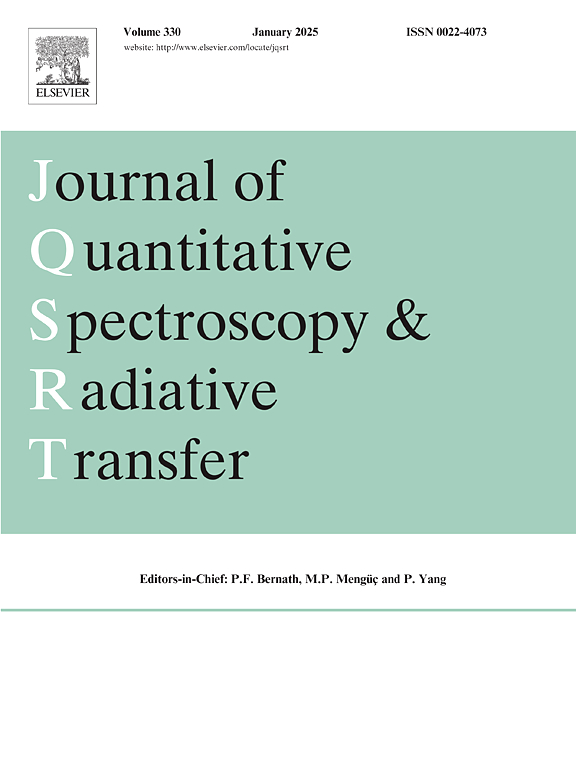Contributions of argon, nitrogen, and oxygen to air broadening in the oxygen A-band
IF 2.3
3区 物理与天体物理
Q2 OPTICS
Journal of Quantitative Spectroscopy & Radiative Transfer
Pub Date : 2025-04-16
DOI:10.1016/j.jqsrt.2025.109480
引用次数: 0
Abstract
The oxygen (O2) A-band is used to determine the airmass in ground- and space-based remote sensing measurements because O2 is well-mixed in the Earth’s atmosphere and its column-integrated amount fraction on a dry-gas basis is nearly constant. Because biases in the retrieved airmass propagate to measurements of target species, low-uncertainty spectroscopic parameters are essential for increasingly precise and accurate greenhouse gas measurements. However, laboratory measurements and atmospheric retrievals of this O2 band typically neglect the line-shape effects caused by collisions with argon (Ar), which comprises 0.934 % by volume of the Earth’s atmosphere. To quantify the contribution of Ar to O2 A-band air-broadening line-shape parameters, we measured pressure broadening and shifting parameters for ten high J lines in the P-branch of this band. These data were acquired in the laboratory over a range of pressures and nitrogen (N2), O2, and Ar amount fractions using cavity ring-down spectroscopy. Respective line-shape parameters for these collisional partners were determined with a multi-spectrum fitting algorithm. These results were combined with literature data to provide an empirical model for the rotational dependencies of the broadening and shifting parameters by each collisional partner. Incorporating these results into analyses of atmospheric column-integrated solar absorption spectra in the O2 A-band shows that the neglect of Ar can lead to a small but potentially relevant systematic bias in surface pressure retrievals and a slight increase in the fit residuals of atmospheric spectra.
氩、氮和氧对氧a波段空气展宽的贡献
在地面和天基遥感测量中,氧(O2) a波段用于确定气团,因为O2在地球大气中混合得很好,在干气基础上,它的柱积分量分数几乎是恒定的。由于反演的气团中的偏差会传播到目标物种的测量中,因此低不确定度的光谱参数对于日益精确和准确的温室气体测量至关重要。然而,实验室测量和大气中O2波段的检索通常忽略了与氩(Ar)碰撞引起的线形效应,氩占地球大气体积的0.934%。为了量化Ar对O2 a波段空气展宽线形参数的贡献,我们测量了该波段p分支的10条高J线的压力展宽和移位参数。这些数据是在实验室中使用腔衰荡光谱在一系列压力和氮气(N2)、氧气和Ar量分数下获得的。采用多谱拟合算法确定了这些碰撞伙伴各自的线形参数。这些结果与文献数据相结合,为每个碰撞伙伴的展宽和移位参数的旋转依赖关系提供了经验模型。将这些结果与O2 a波段大气柱集成太阳吸收光谱的分析相结合,表明忽略Ar会导致地表压力反演的小但可能相关的系统偏差,并且大气光谱的拟合残差略有增加。
本文章由计算机程序翻译,如有差异,请以英文原文为准。
求助全文
约1分钟内获得全文
求助全文
来源期刊
CiteScore
5.30
自引率
21.70%
发文量
273
审稿时长
58 days
期刊介绍:
Papers with the following subject areas are suitable for publication in the Journal of Quantitative Spectroscopy and Radiative Transfer:
- Theoretical and experimental aspects of the spectra of atoms, molecules, ions, and plasmas.
- Spectral lineshape studies including models and computational algorithms.
- Atmospheric spectroscopy.
- Theoretical and experimental aspects of light scattering.
- Application of light scattering in particle characterization and remote sensing.
- Application of light scattering in biological sciences and medicine.
- Radiative transfer in absorbing, emitting, and scattering media.
- Radiative transfer in stochastic media.

 求助内容:
求助内容: 应助结果提醒方式:
应助结果提醒方式:


